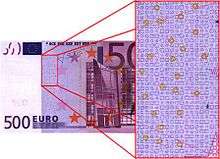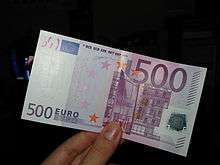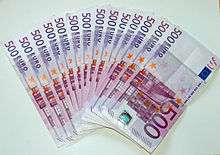500 euro note
| (Eurozone and Institutions) | |
|---|---|
| Value | 500 euro |
| Width | 160 mm |
| Height | 82 mm |
| Security features | Hologram patch with perforations, EURion constellation, watermarks, microprinting, ultraviolet ink, raised printing, security thread, matted surface, see through number, colour-changing ink, barcodes and serial number[1] |
| Paper type | Cotton fibre[1] |
| Years of printing | 1999–2014[2] |
| Obverse | |
.jpg) | |
| Design | Window in Modern architecture[3] |
| Designer | Robert Kalina[4] |
| Design date | 3 December 1996[4] |
| Reverse | |
.jpg) | |
| Design | Bridge in Modern architecture and map of Europe.[3] |
| Designer | Robert Kalina[4] |
| Design date | 3 December 1996[4] |
The five hundred euro note (€500) is the highest-value euro banknote and has been used since the introduction of the euro (in its cash form) in 2002.[5] It is one of the highest value circulating banknotes in the world, worth around 551 USD, 3,677 CNY, 58,254 JPY, 543 CHF or 417 GBP.[6] The note is used in the 23 countries which have the euro as their sole currency (with 22 legally adopting it), with a population of about 338 million.[7]
It is the largest note measuring 160 × 82 mm and has a purple colour scheme.[3] The five hundred euro banknotes depict bridges and arches/doorways in modern architecture (around the late 20th century).[3]
The five hundred euro note contains several complex security features such as watermarks, invisible ink, holograms and microprinting that make counterfeiting very difficult. Initially the high denomination notes were introduced very rapidly so that in first 7 years (by Dec 2008) there were 530,064,413 five hundred euro banknotes in circulation. Subsequently rate of increase was radically slowed. In January 2016 there were 611,833,416 in circulation.
The European Central Bank announced on 4 May 2016 that it would phase out the 500 euro note by the end of 2018.[8][9] “Authorities increasingly suspect that they (€500 notes) are being used for illegal purposes, an argument that we can no longer ignore,” according to a high-ranking bank official, Benoît Cœuré.[8][10]
History
The euro was founded on 1 January 1999, when it became the currency of over 300 million people in Europe.[11] For the first three years of its existence it was an invisible currency, only used in accountancy. Euro cash was not introduced until 1 January 2002, when it replaced the national banknotes and coins of the countries in eurozone 12, such as the Luxembourgish franc.[11]
Slovenia joined the Eurozone in 2007,[12] Cyprus and Malta in 2008,[13] Slovakia in 2009,[14] Estonia in 2011,[15] Latvia in 2014[16] and Lithuania joined on 1 January 2015.
The changeover period
The changeover period during which the former currencies' notes and coins were exchanged for those of the euro lasted about two months, going from 1 January 2002 until 28 February 2002. The official date on which the national currencies ceased to be legal tender varied from member state to member state.[11] The earliest date was in Germany, where the mark officially ceased to be legal tender on 31 December 2001, though the exchange period lasted for two months more. Even after the old currencies ceased to be legal tender, they continued to be accepted by national central banks for periods ranging from ten years to forever.[11][17]
Changes
Notes printed before November 2003 bear the signature of the first president of the European Central Bank, Wim Duisenberg, who was replaced on 1 November 2003 by Jean-Claude Trichet, whose signature appears on issues from November 2003 to March 2012. Notes issued after March 2012 bear the signature of the third president of the European Central Bank, incumbent Mario Draghi.[3]
As of June 2012, current issues do not reflect the expansion of the European Union. Cyprus is not depicted on current notes as the map does not extend far enough east and Malta is also missing as it does not meet the current series' minimum size for depiction.[18] The European Central Bank is currently introducing a new series of Euro-banknotes.[19] The 500 euro denomination, however, will not be included in the new series as it was decided to phase out issuance of 500 euro banknotes.[8]
Design
The five hundred euro note measures at 160 millimetres (6.3 in) × 82 millimetres (3.2 in)[20] with a purple colour scheme.[20] All bank notes depict bridges and arches/doorways in a different historical European style; the five hundred euro note shows Modern architecture (around the 20th century).[20] Although Robert Kalina's original designs were intended to show real monuments, for political reasons the bridge and art are merely hypothetical examples of the architectural era.[21] Neverthless, the featured bridge is highly similar to Guadiana International Bridge.
Like all euro notes, it contains the denomination, the EU flag, the signature of the president of the ECB and the initials of said bank in different EU languages, a depiction of EU territories overseas, the stars from the EU flag and twelve security features as listed below.[3]
Security features

The five hundred euro note is protected by:
- Colour changing ink[20] used on the numeral located on the back of the note, that appears to change colour from purple to brown, when the note is tilted.[22]
- A see through number[20] printed in the top corner of the note, on both sides, appear to combine perfectly to form the value numeral when held against the light.[23]
- A glossy stripe,[20] situated at the back of the note, showing the value numeral and the euro symbol.[20]
- A hologram,[20] used on the note which appears to see the hologram image change between the value and a window or doorway, but in the background, it appears to be rainbow-coloured concentric circles of micro-letters moving from the centre to the edges of the patch.[22]
- A EURion constellation;[20] the EURion constellation is a pattern of symbols found on a number of banknote designs worldwide since about 1996. It is added to help software detect the presence of a banknote in a digital image.[20]
- Watermarks,[20] which appear when held up to the light.[20]
- Raised printing[20] in the main image, the lettering and the value numerals on the front of the banknotes will be raised.[24]
- Ultraviolet ink;[20] the paper itself does not glow, fibres embedded in the paper do appear, and be coloured red, blue and green, the EU flag is green and has orange stars, the ECB President's, currently Mario Draghi's, signature turns green, the large stars and small circles on the front glow and the European map, a bridge and the value numeral on the back appear in yellow.[25]
- Microprinting,[20] on various areas of the banknotes there is microprinting, for example, inside the "EYPΩ" (EURO in Greek characters) on the front. The micro-text is sharp, but not blurred.[25]
- A security thread,[20] embedded in the banknote paper. The thread will appear as a dark stripe when held up to the light. The word "EURO" and the value is embedded in tiny letters on the thread.[23]
- Perforations[20] in the hologram which will form the euro symbol. There are also small numbers showing the value.[23]
- A matted surface;[20] the note paper is made out of pure cotton, which feels crisp and firm, but not limp or waxy.[24]
- Barcodes,[20]
- A serial number.[20]
Crime

The value of the note is several times greater than many of the largest circulating notes of other major currencies, such as the United States 100 dollar bill.[26] Thus a large monetary value can be concentrated into a small volume of notes. This facilitates crimes that deal in cash, including money laundering, drug dealing, and tax evasion.[27] There have been calls to withdraw the note for this reason.[28][29][30][31][32] However, some of the currencies the Euro replaced had widely used high-value notes, including the 10,000 Belgian francs (€247.89), 5,000 Austrian schillings (€363.36), and 1,000 Dutch guilders (€453.78), although these did not exceed the value of the €500 note. Two exceptions were the 1,000 Deutsche Marks, which had an equivalent value of €511.29, and 500 Latvian lats, which had an equivalent value of €711.44.[26] But while these national currency banknotes had similar face value, the numbers of banknotes circulated was considerably smaller. For instance approx 93 million of the German 1000 DEM banknotes was circulating in the year 2000, far fewer than the over five hundred million 500 Euro banknotes circulating in less than 7 years after the Euro banknotes were introduced.
In particular, Spain had a quarter of all these high-value bills within its borders in 2006.[28] This concentration of €500 notes is far greater than expected for an economy of Spain's size, as prior to Euro conversion the largest banknote was 10,000 Spanish peseta worth ~ €60. These notes are rarely seen in every-day commerce – they have been nicknamed "Bin Ladens" by the populace (as the presence and appearance of the notes are well-known, but the notes themselves are very difficult to find).[33][34][35] British and Spanish police are using the bills to track money laundering.[28][29]
As of 20 April 2010, money exchange offices in the United Kingdom stopped selling €500 notes due to their use in money laundering.[36] The Serious Organised Crime Agency claimed that "90% of all €500 notes sold in the UK are in the hands of organised crime", revealed during an eight-month analysis.[36] The €500 note is worth in the region of £400,[6] depending on exchange rates (more than eight times the value of the Bank of England's largest publicly circulated note), and had become the currency choice for gangs to hide their profits.[36]
The EU directive 2005/06/EC[37] "on the prevention of the use of the financial system for the purpose of money laundering and terrorist financing" tries to prevent such crime by requiring banks, real estate agents, tax and business advisors or agents, casinos and more companies to investigate and report usage of cash in excess of €15,000.[37]
Circulation

As of December 2015, there were approximately 613,559,542 €500 banknotes in circulation around the Eurozone, therefore it is the second-least circulated banknote in the Eurozone.[38] That is approximately €306,779,771,000 worth of €500 banknotes.[38] The European Central Bank closely monitors the stock and circulation of euro notes and coins. It is the Eurosystem’s task to ensure an efficient and smooth supply of euro notes and to maintain their integrity.[38]
Legal information
Legally, both the European Central Bank and the central banks of the eurozone countries have the right to issue the 7 different euro banknotes. In practice, only the national central banks of the zone physically issue and withdraw euro banknotes. The European Central Bank does not have a cash office and is not involved in any cash operations.[11]
Tracking
There are several communities of people at European level, most of which is EuroBillTracker,[39] that, as a hobby, it keeps track of the euro banknotes that pass through their hands, to keep track and know where they travel or have travelled.[39] The aim is to record as many notes as possible to know details about its spread, like from where and to where they travel in general, follow it up, like where a ticket has been seen in particular, and generate statistics and rankings, for example, in which countries there are more tickets.[39] EuroBillTracker has registered over 155 million notes as of May 2016,[40] worth more than €2.897 billion.[40]
References
- 1 2 "ECB: Security Features". European Central Bank. ecb.int. 2002. Retrieved 22 October 2011.
- ↑ "Banknotes and coins production". Retrieved 5 May 2016.
- 1 2 3 4 5 6 "ECB: Banknotes". European Central Bank. European Central Bank. 2002. Retrieved 13 October 2011.
- 1 2 3 4 "ECB: Banknotes design". ECB. ECB. February 1996. Retrieved 13 October 2011.
- ↑ Young, Alf (1 January 2002). "Witnessing a milestone in European history". The Herald. Back Issue. Retrieved 23 October 2011.
- 1 2 Approximate conversion rates (rounded) from XE.com on Mar 24, 2016
- ↑
- "Andorran Euro Coins". Eurocoins.co.uk. Eurocoins.co.uk. 2003. Retrieved 15 October 2011.
- "By UNMIK administration direction 1999/2". Unmikonline.org. 4 October 1999. Archived from the original on 7 June 2011. Retrieved 30 May 2010.
- "By monetary agreement between France (acting for the EC) and Monaco". 31 May 2002. Retrieved 30 May 2010.
- "By monetary agreement between Italy (acting for the EC) and San Marino". 27 July 2001. Retrieved 30 May 2010.
- "By monetary agreement between Italy (acting for the EC) and Vatican City". 25 October 2001. Retrieved 30 May 2010.
- "ECB: Map of euro area 1999 – 2011". ECB. ecb.int. 1 January 2011. Retrieved 27 October 2011.
- "Total population as of 1 January". Epp.eurostat.ec.europa.eu. 11 March 2011. Archived from the original on 20 July 2011. Retrieved 17 July 2011.
- 1 2 3 "ECB ends production and issuance of €500 banknote" (Press release). Frankfurt, Germany: European Central Bank. 4 May 2016. Retrieved 2016-11-16.
- ↑ http://www.nytimes.com/2016/05/05/business/international/ecb-to-remove-500-bill-the-bin-laden-bank-note-criminals.html
- ↑ "ECB 'planning to axe €500 note'". The Connexion.
- 1 2 3 4 5 "ECB: Introduction". ECB. ECB. Retrieved 21 October 2011.
- ↑ "Slovenia joins the euro area - European Commission". European Commission. 16 June 2011. Archived from the original on 11 September 2013. Retrieved 6 August 2013.
- ↑ "Cyprus and Malta adopt the euro - BBC NEWS". BBC News. British Broadcasting Corporation. 1 January 2008. Retrieved 6 August 2013.
- ↑ Kubosova, Lucia (31 December 2008). "Slovakia Joins Decade-Old Euro Zone - Businessweek". Bloomberg Businessweek. Bloomberg. Retrieved 6 August 2013.
- ↑ "Estonia to join euro zone in 2011". RTÉ News. Radió Teilifís Éireann. 13 July 2010. Retrieved 6 August 2013.
- ↑ Van Tartwijk, Maarten; Kaza, Juris (9 July 2013). "Latvia Gets Green Light to Join Euro Zone -WSJ.com". Wall Street Journal. Wall Street Journal. Retrieved 31 July 2013.
- ↑ "Press kit - tenth anniversary of the euro banknotes and coins" (PDF). ECB. Central Bank of Ireland. 2011. Retrieved 21 August 2012.
- ↑ European Central Bank. "The Euro: Banknotes: Design elements". Retrieved 2009-07-05.
The banknotes show a geographical representation of Europe. It excludes islands of less than 400 square kilometres because high-volume offset printing does not permit the accurate reproduction of small design elements.
- ↑ The life cycle of a banknote Archived 26 September 2007 at the Wayback Machine., De Nederlandsche Bank. Accessed 2007-08-17.
- 1 2 3 4 5 6 7 8 9 10 11 12 13 14 15 16 17 18 19 20 "ECB: Security Features". ECB. ECB.
- ↑ "Money talks – the new Euro cash". BBC News. BBC News. December 1996. Retrieved 13 October 2011.
- 1 2 "ECB:Tilt". ECB. ecb.int. 1 January 2002. Retrieved 22 October 2011.
- 1 2 3 "ECB: Look". ECB. ecb.int. 1 January 2002. Retrieved 22 October 2011.
- 1 2 "ECB: Feel". ECB. ecb.int. 1 January 2011. Retrieved 22 October 2011.
- 1 2 "ECB: Additional features". ECB. ecb.int. 1 January 2002. Retrieved 22 October 2011.
- 1 2 "500 euro". BBC News. Retrieved 25 April 2011.
- ↑ Euro Trash Slate
- 1 2 3 McLean, Renwick (19 April 2006). "One in four €500 bills are in Spain. Why? Crime might be the answer". New York Times. Retrieved 2 May 2011.
- 1 2 The raid in Spain Digital money forum
- ↑ The raid in Spain
- ↑ Eurozone ponders fate of €500 note, which some link to criminal activity Coin World (www.coinworld.com). February 11, 2016. Retrieved on 2016-02-14.
- ↑ The EU Is Banning the 500-euro 'Bin Laden' Bill to Try and Stop Terrorists Vice News (news.vice.com). February 18, 2016. Retrieved on 2016-02-18.
- ↑ Doyle, Jack (13 May 2010). "'Currency of the criminal': Britain axes 500 euro note over organised crime fears". Daily Mail. Retrieved 21 August 2015.
- ↑ Hughes, Mark; Sharp, Rob (13 May 2010). "Goodbye to the note of ill-repute". The Independent. Retrieved 21 August 2015.
- ↑ Casciani, Dominic (13 May 2010). "500 euro note – why criminals love it so". BBC News.
- 1 2 3 Casciani, Dominic (13 May 2010). "Organised crime fears cause ban on 500 euro sales". BBC News. Retrieved 25 October 2011.
- 1 2 "Directive 2005/60/EC of the European Parliament and of the Council of 26 October 2005 on the prevention of the use of the financial system for the purpose of money laundering and terrorist financing". Eur-lex.europa.eu. Retrieved 25 April 2011.
- 1 2 3 "ECB: Circulation". European Central Bank. European Central Bank. December 2015. Retrieved 26 January 2016.
- 1 2 3 "EuroBillTracker - About this site". Philippe Girolami, Anssi Johansson, Marko Schilde. EuroBillTracker. 1 January 2002. Retrieved 21 October 2011.
- 1 2 "EuroBillTracker - Statistics". Philippe Girolami, Anssi Johansson, Marko Schilde. EuroBillTracker. 1 January 2002. Retrieved 21 October 2011.
External links
-
 Media related to 500 euro banknotes at Wikimedia Commons
Media related to 500 euro banknotes at Wikimedia Commons